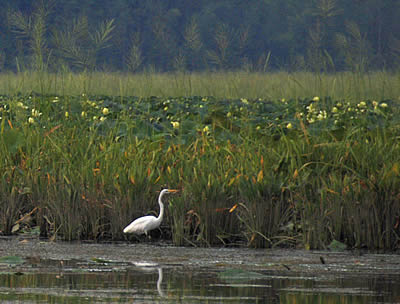
Mattawoman Creek
Photos and narrative by Jim Long.
Egret amid Lotus blooms at tidal-freshwater Mattawoman Creek, Charles Co., MD, photographed by Jim Long, August 16, 2007
An example of the botanically rich tidal-freshwater marshes of Mattawoman Creek. Submerged aquatic vegetation breaks the surface in the foreground. Behind the Great Egret is a "pickeral weed-arrow arum low tidal freshwater marsh," perhaps a locally abundant community in eastern Maryland, but uncommon globally (G3-Nature Serve). Wild Rice towers above, and the yellow blooms beyond are American Lotus, ranked S2 ("imperiled") in Maryland. Mattawoman is one of three sites in the state where natural populations of this emergent are found. Further removed are high-marsh communities, that in fall will dazzle with blooming Bidens. And in the background is a riverside woods - symbolizing the importance of a forested watershed in maintaining the water quality that makes such high-quality marshes possible, not to mention the most balanced fish food-web and most productive fishery in the Chesapeake Bay, enjoyed by unusually large populations of Herons and Egrets.
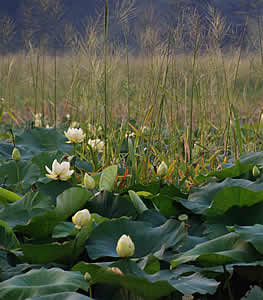
Lotus field & Rice at tidal Mattawoman Creek, Charles Co., MD, photographed by Jim Long, August 16, 2007
Even when the American Lotus is not blooming, the circular, bluish-green elephantine leaves stand out in the tidal freshwater marshes of Mattawoman Creek. The more common Wild Rice nods above.
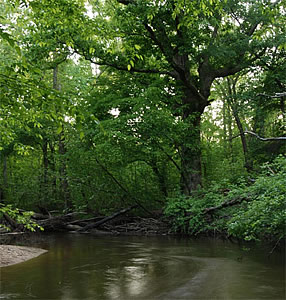
Lyre Leaf Oak at non-tidal Mattawoman Creek, Charles Co., MD, photographed by Jim Long, May 13, 2007
A venerable Overcup Oak, Quercus lyrata, anchors the bank of the fluvial portion of Mattawoman Creek. Also known as the Swamp Post Oak or Lyre-leaf Oak, this elegant specimen measures 13 feet in circumference at breast height. Overcup refers to the acorn's cap, or cup, that nearly encases the entire nut. Maryland is at the northern edge of the Overcup's range and was once ranked on the state RT&E list. Unfortunately, this specimen lies in the path of a proposed new highway in Charles County, the ill-conceived extension of the county’s Cross County Connector through the Mattawoman Watershed. Please see www.mattawomanwatershed.org for more information.

Ironweed at Cedarville marsh in non-tidal Mattawoman Creek, Prince Georges Co., MD, photographed by Jim Long, early October, 1997
A successional beaver meadow in the upper reaches of fluvial Mattawoman Creek near Cedarville State Forest shows late-blooming bonesets and, in the foreground, a New York Ironweed. Beavers once engineered habitat variety such as seen here throughout much of the continental United States.
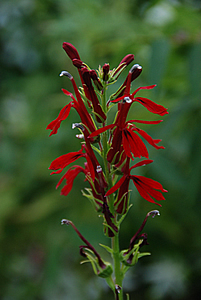
Cardinal flower at tidal Mattawoman Creek, Charles Co., MD, photographed by Jim Long, August 16, 2007
The open habitat in a tidal freshwater estuary supports many moisture-loving flowering plants, including the occasional Cardinal Flower, also a habitué of streamsides.
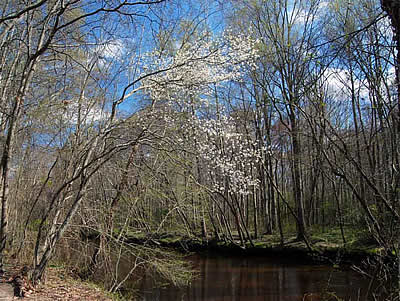
Shadbush along tidal Mattawoman Creek, Charles Co., MD, photographed by Jim Long, April 8, 2007
A Shadbush arcs over tannin-stained Mattawoman Creek near head of tide. While not necessarily a riverside tree, the Shadbush is named for its time of bloom around the start of the migratory American Shad spawning runs that once surged with great schools throughout the rivers of the east coast. The location of this fine specimen is especially appropriate, as Hickory Shad, a close cousin to the American, visit this reach of stream in April and May. Mattawoman exhibits unusually large numbers of American Shad as well, as stocking with fry protectively raised from local eggs gradually increases numbers in the Potomac River, even as populations remain depressed throughout the eastern seaboard. As with all migratory animals, anadromous fish like the Shads, which live in the ocean but must spawn in freshwater, are threatened by a human-dominated environment.

Tickseed sunflowers at tidal Mattawoman Creek, Charles Co., MD, photographed by Jim Long, October 2, 2007
In fall, Tickseed Sunflowers, or Bidens, seem to dominate the high-marsh habitat throughout tidal freshwater Mattawoman Creek. Among the flowers are tree snags that have succumbed to gradually rising water levels, possibly a consequence of the sea-level rise observed over the past century. Increasing rates of rise are predicted as a consequence of global warming. Climate change may bring big changes to freshwater tidal marshes through flooding - many marshes are thwarted in migrating by urbanized encroachment - and saltwater incursion. Non-tidal waters are also at risk, as larger predicted weather fluctuations exacerbate the flood & low-flow "flashiness" that urbanization brings to our streams.